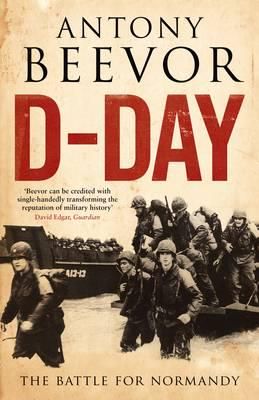D-Day: The Battle for Normandy
The Normandy Landings that took place on D-Day involved by far the largest invasion fleet ever known. The scale of the undertaking was simply awesome. What followed them was some of the most cunning and ferocious fighting of the war, at times as savage as anything seen on the Eastern Front. As casualties mounted, so too did the tensions between the principal commanders on both sides. Meanwhile, French civilians caught in the middle of these battlefields or under Allied bombing endured terrible suffering. Even the joys of Liberation had their darker side. Antony Beevor's gripping narrative conveys the true experience of war.
Even Stalin was awed by D-Day.'In the whole history of war,' he wrote to Churchill, 'there has never been such an undertaking.' Those who took part in the great cross-Channel invasion, whether soldier, sailor or airman, would never forget the sight. It was by far the largest invasion fleet ever known. Nor, of course, would the German defenders alerted at the last moment on the Normandy coasts.
The very scale of the undertaking and its meticulous planning were unprecedented, but although the beachheads were established as planned, it soon became clear that the next stage of the battle would be far more difficult than anyone had imagined. The thick hedgerows of Normandy were ideal for the defender, and the Germans, especially the Waffen-SS divisions, fought with cunning and a desperate ferocity. As they made their way inland, the British, Canadian and American forces became involved in battles whose savagery was often comparable to the Eastern Front.
Casualties began to mount and so did the tension between the principal commanders on both sides. French civilians, caught in the middle of these battlefields or under Allied bombing, endured terrible suffering. Even the joys of Liberation had their darker side. The war in northern France marked not just a generation but the whole of the post-war world, profoundly influencing relations between America and Europe.
Making use of overlooked and new material from over thirty archives in half a dozen countries, D-Day is the most vivid and well-researched account yet of the battle of Normandy. As with Stalingrad and Berlin - The Downfall, Antony Beevor's gripping narrative conveys the true experience of war.
| Author | Antony Beevor |
|---|---|
| Publisher | Viking |
| Place | London |
| Year | 2009 |
| ISBN | 9780670887033 |
| Binding | Hardcover |
| Condition | Good |
| Dustjacket Condition | Very Good |
| Comments | Evidence of minor moisture at bottom right corner of +- first 100 pages, otherwise in very good condition; inscription on second page. |
How we describe the condition of our books
We are very proud of the condition of the books we sell (please read our testimonials to find out more!)
New: Exactly as it says.
As New: Pretty much new but shows small signs of having been read; inside it will be clean without any inscriptions or stamps; might contain a remainder mark.
Very Good: Might have some creases on the spine; no hard cracks; maybe slight forward lean and short inscription inside; perhaps very minor bumping on the corners of the book; inside clean but the page edges might be slightly yellowed.
Good: A few creases on the spine, perhaps a forward lean, bumping on corners or shelfwear; maybe an inscription inside or some shelfwear or a small tear or two on the dustjacket; inside clean but page edges might be somewhat yellowed.
Fair: In overall good condition, might have a severe forward lean to the spine, an inscription, bumping to corners; one or two folds on the covers and yellowed pages; in exceptional cases these books might contain some library stamps and stickers or have neat sticky tape which was used to fix a short, closed tear.
Poor: We rarely sell poor condition books, unless the books are in demand and difficult to find in a better condition. Poor condition books are still perfect for a good read, all pages will be intact and none threatening to fall out; most probably a reading copy only.


